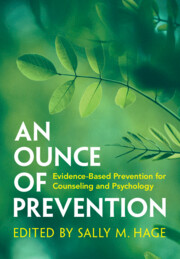Book contents
- An Ounce of Prevention
- An Ounce of Prevention
- Copyright page
- Dedication
- Contents
- Figures
- Contributors
- Acknowledgments
- Part One A Foundation in Prevention
- 1 The Practice and Science of Prevention: Introduction and Overview
- 2 Best Practices for the Evaluation of Prevention Programs
- 3 Critical Features of Prevention Practice: Implementing Prevention That Works
- Part Two Prevention with Children and Youth
- Part Three Prevention with Emerging Adults
- Part Four Across the Lifespan: Adults and Families
- Part Five Closing
- Index
- References
1 - The Practice and Science of Prevention: Introduction and Overview
from Part One - A Foundation in Prevention
Published online by Cambridge University Press: 14 November 2024
- An Ounce of Prevention
- An Ounce of Prevention
- Copyright page
- Dedication
- Contents
- Figures
- Contributors
- Acknowledgments
- Part One A Foundation in Prevention
- 1 The Practice and Science of Prevention: Introduction and Overview
- 2 Best Practices for the Evaluation of Prevention Programs
- 3 Critical Features of Prevention Practice: Implementing Prevention That Works
- Part Two Prevention with Children and Youth
- Part Three Prevention with Emerging Adults
- Part Four Across the Lifespan: Adults and Families
- Part Five Closing
- Index
- References
Summary
An orientation to prevention is critical to abate the existing mental health crisis, with one in five US adults presently having a mental illness. The unmet need for mental health services is grounded in tenacious health, social, racial, and economic disparities, exacerbated by the pandemics of COVID-19 and racism. These realities present an unremitting threat to people’s lives, their physical welfare, and their psychological and social well-being. Despite a dearth of prevention training, psychologists and counselors may be best positioned to engage in prevention work. As professionals, we often feel powerless to prevent human suffering, and yet, we yearn, deep in our hearts, for a way to intervene earlier so as to prevent pain in our communities, intuitively aware that a way exists to make people’s lives easier and our work more impactful. This chapter introduces the approach of the book, which is to provide mental health professionals with the knowledge, resources, and tools to engage in “before-the-fact” intervention, to apply an ounce of prevention to the work we do, and to utilize a strength-based, culturally focused framework. In addition, this chapter provides a rationale and definition of prevention and an overview of the model prevention programs presented in this book.
Keywords
Information
- Type
- Chapter
- Information
- An Ounce of PreventionEvidence-Based Prevention for Counseling and Psychology, pp. 3 - 22Publisher: Cambridge University PressPrint publication year: 2024
